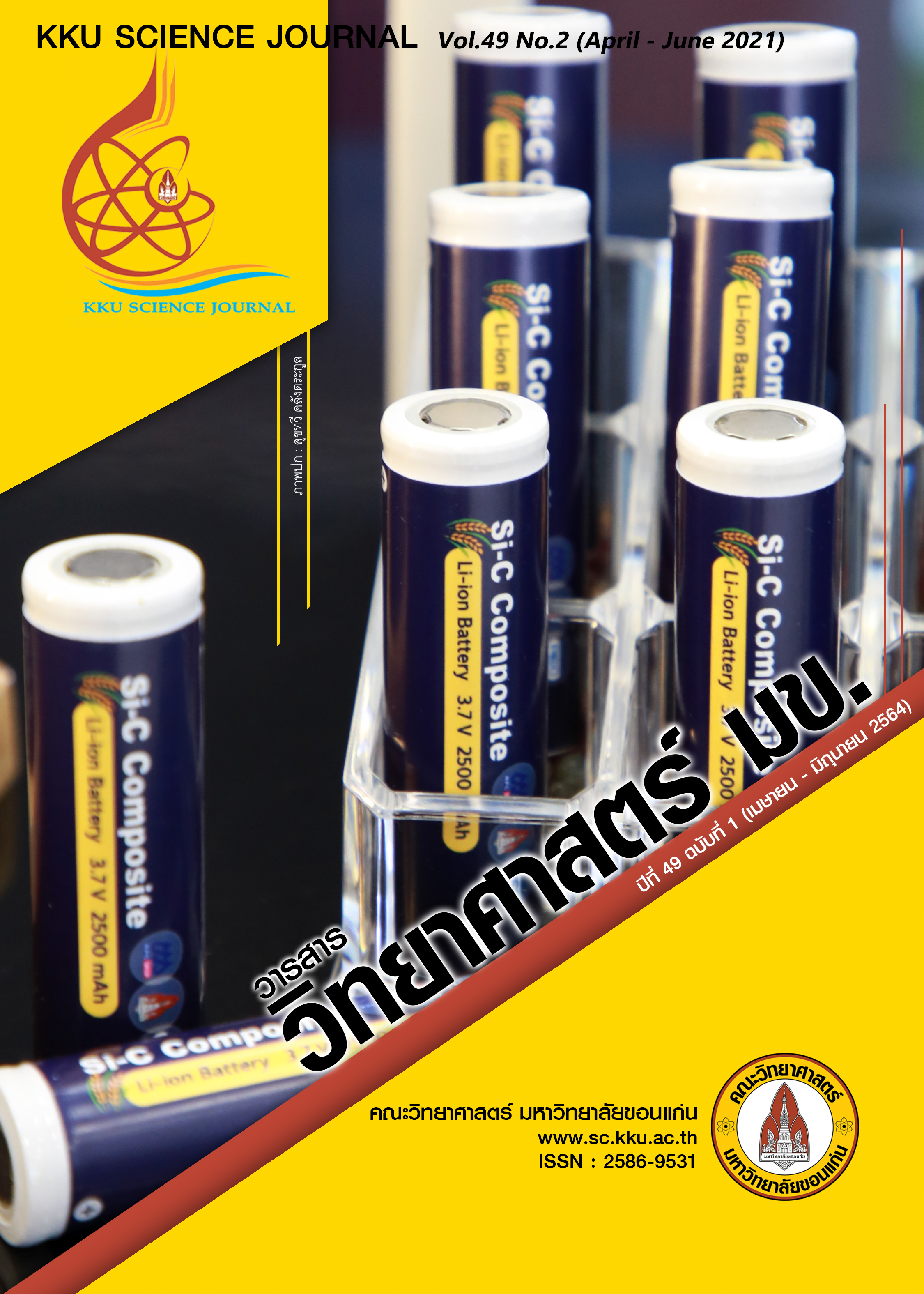Karyotypes of three grasshopper species (Othoptera: Acrididae/Pyrgomorphidae) in Udon Thani province
Main Article Content
Abstract
This research aimed to examine karyotypes of some grasshopper species in the family Acrididae and Pyrgomorphidae. Ten adult male specimens of each species were collected in the area of Samprao campus, Udon Thani Rajabhat University. The metaphase chromosomes were prepared from mitotic dividing cells in testes (spermatogonia). Conventional staining was applied using 10% Giemsa’s solution. The results showed that white-tipped grasshopper (Phlaeoba antennata) had a diploid chromosome number of 2n = 23. Karyotype was consisted of all telocentric chromosomes, and karyotype formula was 2n (23) = Lt8+Mt2+St12+XO. Testaceous oblique-faced grasshopper (P. infumata) had a diploid chromosome number of 2n = 23, karyotype comprised all telocentric chromosomes, and karyotype formula was 2n (23) = Lt10+Mt8+St4+XO. Orange-winged slant-faced grasshopper (Tagasta marginella) had a diploid chromosome number of 2n = 19, karyotype was composed of all telocentric chromosomes, and karyotype formula was 2n (19) = Lt6+Mt10+St2+XO. Sex determination of these grasshopper species was XX and XO system. These cytogenetic data can be employed as a source of taxonomic information which is provide more details for evolutionary relationship knowledge of these insect groups in the future.
Article Details

This work is licensed under a Creative Commons Attribution-NonCommercial-NoDerivatives 4.0 International License.
References
Aswathanarayana, N. V. and Ashwath, S. K. (2006). Structural polymorphism and C-banding pattern in a few Acridid grasshoppers. Cytology 71(3): 223-228.
Cella, D. M. and Ferreira, A. (1991). The cytogenetics of Abracris flavolineata (Orthoptera, Caelifera, Ommatolampinae, Abracrini). Revista brasileira de genética 14: 315-329.
Chadha, P. and Mehta, A. (2011). Chromosome study in few species of acridids (Acrididae: Tryxalinae): Karyotypic analysis and distribution patterns of constitutive heterochromatin. Journal of entomology and nematology 3(1): 14-19.
Chaiyasut, K. (1989). Cytogenetics and cytotaxonomy of the family Zephyranthes. Bangkok. Faculty of Science, Chulalongkorn University, Department of Botany. pp. 260.
Channaveerappa, H. and Ranganath, H. (1997). Karyology of few species of south Indian acridids. II Male germ line karyotypic instability in Gastrimargus. Journal of Biosciences 22(3): 367-374.
Chaweewan, H., Nopachonm, T. and Chutima, D. (2007). Checklists of Insects and Mites in Thailand. Bangkok. Department of National Parks, Wildlife and Plant Conservation Minisrty of Natural Resources and environment. pp. 319.
Ek-Amnuay, P. (2013). Grasshoppers. 1st Edition. Bangkok: Pluspress. pp. 40.
Ferreira, A., Mesa, A. and Carbonell, C. S. (1980). The chromo-somes of neotropical short-horned grasshoppers of the tribe Abracrini (Orthoptera, Acridoidea, Acrididae, Ommatolampinae). Naturalia 5: 89-95.
Grzimek, B., Kleiman, D. G., Geist, V. and McDade, M. C. (2004). Grzimek's Animal Life Encyclopedia. 1st Edition. Detroit: Thomson-Gale. pp. 371.
Hewitt, G. M. (1979). Grasshoppers and Crickets. Animal cytogenetics. Insecta, I. Orthoptera. Vol. 3. Borntraeger G, Editors. Berlin: Stuttgart. pp.170.
Koli, J. Y., Gaikwad, M. S., Bharmal, L. D. and Bhawane, P. G. (2013). Karyotypic Studies of Six Species of Grasshopper (Orthoptera: Acrididae) from Kolhapur District, Maharashtra, India. Cytologia 78(3): 255-260.
Ma, E. B. and Zheng, Z. M. (1989). Comparison of katyotypes and chromosome C-banding patterns in five species of Oxya. Acta Entomologica Sinica 32(4): 399-405.
Ma, E. B., Guo, Y. P. and Zheng, Z. M. (1994). Cytotaxonomic study of Oxya species in China (Orthoptera: Acridoidea). Journal of Insect Science 1(2): 101-109.
Mesa, A., Ferreira, A. and Carbonell, C. S. (1982). Cariologia de los Acridoideos neotropicales: Estado actual de su conocimientoy nuevas contribuciones. Annales de la Société Entomologique de France (N.S.) 18: 507-526.
Mesa, A. and Fontanetti, C. S. (1983). Karyotypes of nine Brazilian species of acridids (Orthoptera, Acridoidea). Revista brasileira de genética 6: 295-305.
Phimphan, S., Sangpakdee, W., Sangpakdee, K. and Tanomtong, A. (2017). Chromosomal analysis and meiosis studies of Oxyachinensis (Orthoptera: Acrididae) from Thailand. Nucleus 60(1): 9-15.
Phimphan, S. and Sangpakdee, W. (2018). Karyotype of Short-winged Rice Grasshopper (Pseudoxya diminutaWalker, 1871) in Thailand. The Science Journal of Phetchaburi Rajabhat University 15(2): 34-40.
Phimphan, S., Tanomtong, A., Sangpakdee K. and Sangpakdee, W. (2018). Chromosome and Meiotic Division of Migratory Bird Locust (Cyrtacanthacris tataricaLinnaeus, 1758) in Thailand. KKU Science Journal 46(3): 469-477.
Qing, L., Xiaohong, O. and Hongjie, G. (2012). C-banding karyotypes of two Caryanda (Orthoptera: Catantopidae) species with short wings from China. Annals of the Entomological Society of America 122(1): 1-9.
Rocha, M. F., Melo, N. F. and Souza, M. J. (2011). Comparative cytogenetic analysis of two grasshopper species of the tribe Abracrini (Ommatolampinae, Acrididae). Genetics and Molecular Biology 34(2): 214-219.
Sandhu, S. K. and Chadha, P. (2012). Karyological studies of four species of grasshoppers from Gurdaspur district of Punjab, India. Nucleus 55(3): 167-170.
Sharma, T. and Gautam, D. C. (2002). Karyotypic studies of eleven species of grasshoppers from north-western Himalayas. Nucleus. 45(1-2): 27-35.
Srinivasan, G. and Prabakar, D. (2013). A Pictorial Handbook on Grasshoppers of Western Himalayas. India. the Director, Zool Surv. India, Kolkata. pp. 75.
White, M. J. D. (1973). Animal cytology and Evolution. 3rd Edition. United Kingdom. Cambridge Univsersity Press. pp. 468.
Yadav, J. S. and Yadav, A. S. (1986). Chromosome number and sexdetermining mechanisms in thirty species of Indian Orthoptera. Folia Biologica 34(3): 277-284.
Yoshimura, A., Obara, Y., Ando, Y. and Kayano, H. (2005). Comparative karyotype analysis of grasshoppers in the genus Oxya (Orthoptera, Catantopidae) by differential staining techniques. Cytologia 70: 109-17.


